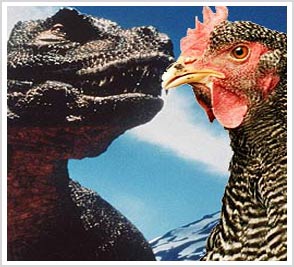Tyrant dinosaurs are brothers with chickens
Tiny pieces of protein taken from a 68 million-year-old dinosaur bone have provided the first genetic evidence that suggests that the tyrant dinosaurs are distant relatives of chickens today.
"This is the first molecular evidence that shows the link between birds and dinosaurs," said Dr. John Asara, a Harvard Medical School student.
Many scientists have speculated that birds evolved from dinosaurs, based on a study of the bones of these ancient reptiles. However, until recently, no soft tissue was available to confirm that hypothesis.
 (Photo: smh.com.au) Things changed in 2005, when assistant professor Mary Higby Schweitzer from North Carolina State University reported finding soft tissue, including blood vessels and cells, in one The piece of the tyrant dinosaur bone found in the sandstone class in Montana.
(Photo: smh.com.au) Things changed in 2005, when assistant professor Mary Higby Schweitzer from North Carolina State University reported finding soft tissue, including blood vessels and cells, in one The piece of the tyrant dinosaur bone found in the sandstone class in Montana.
To serve his research, Asara used a highly sensitive mass spectrometry technique to determine the chemical composition of bone fragments provided by Schweitzer's team. First, he cleans out bone fragments, then splits it into peptide fragments (small parts of the protein), and then isolates it into amino acid sequences.
Asara has acquired seven distinct amino acid sequences, five of which are a special type of collagen - a fibrous protein found in bone. Next, he translated this sequence, and compared the collagen data of the living animals. Most of them are compatible with chicken collagen, while others are compatible with newts and frogs' collagen.
"Based on all the genetic information we have today, it can be seen that these sequences are closer to birds or chickens," Asara said.
Finally, the scientists hope to find the gene characteristic of the tyrant dinosaur, but this is not possible with such a small amount of samples.
Schweitzer, in another study, found that bone fragments of tyrant dinosaurs responded to antibodies in chicken collagen. This confirms the presence of bird-like proteins in dinosaur bones.
T. An
- Hey, I am the T-Rex tyrant of Jurassic World and you are all wrong about me!
- T-rex tyrant dinosaurs also know 'love' - the shocking study of scientists
- Discover embryos in eggs, dinosaurs are revived?
- Discover super big tyrant dinosaurs
- New research confirms T. rex tyrant dinosaurs have no feathers
- Tyrant dinosaurs are granted Dutch passports
- Can humans beat the tyrant dinosaurs?
- Fossil is suspected of being a child tyrant dinosaur in America
- Detecting tyrannical dinosaurs with beautiful feathers
- New research on the steps of T-Rex tyrant dinosaurs
- Create modern chickens with dinosaur legs for evolutionary research
- Decode secret million years of the most giant monster on Earth
 Discovered an ancient centipede fossil 99 million years old
Discovered an ancient centipede fossil 99 million years old Discovered bat-like dinosaurs in China
Discovered bat-like dinosaurs in China Discovered a 200-year-old bronze cannon of the coast
Discovered a 200-year-old bronze cannon of the coast Discover 305 million-year-old spider fossils
Discover 305 million-year-old spider fossils